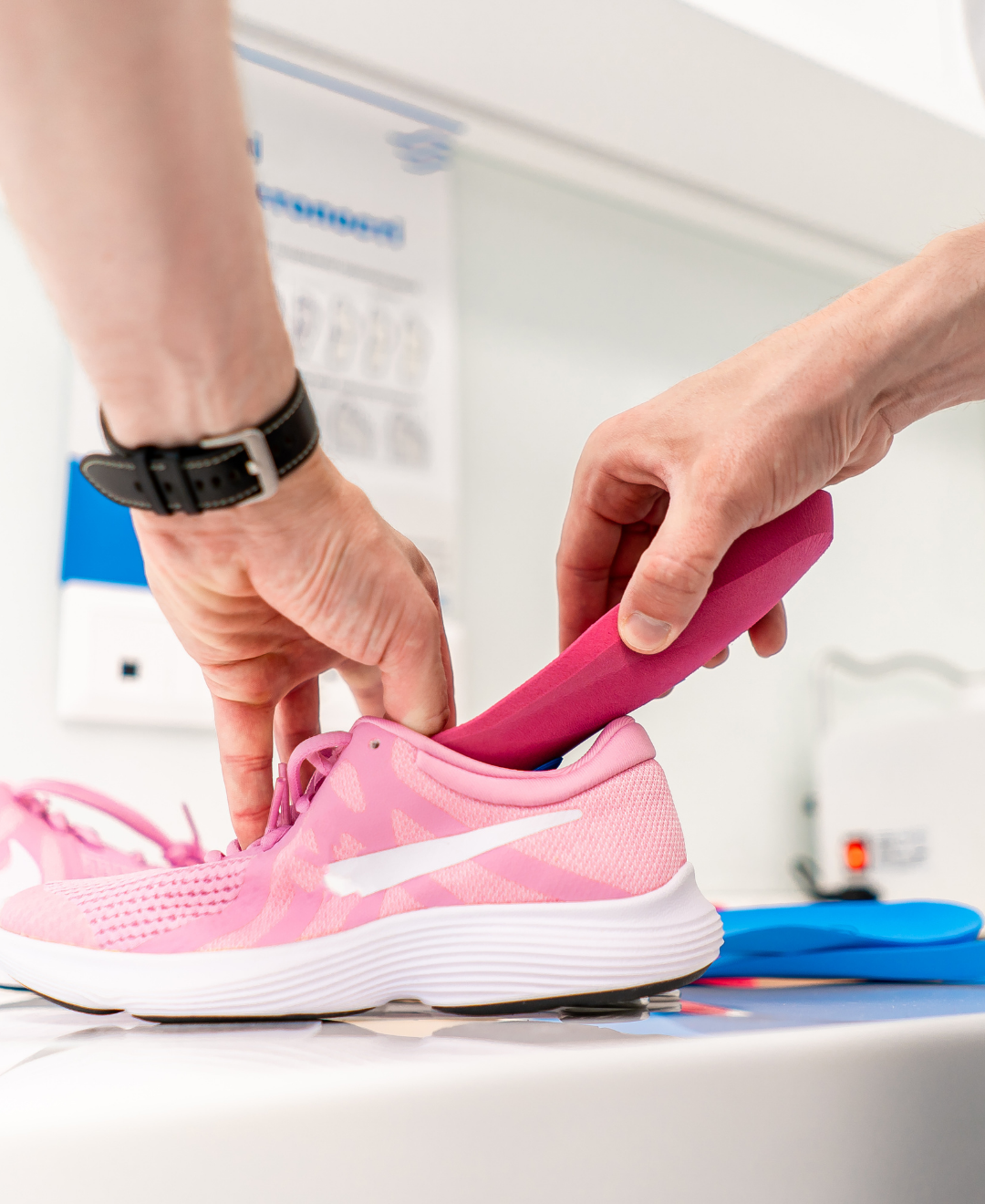
3D PRINTED CUSTOMISED ORTHOTICS
What does every female British marathon champion runner trust for the last six years for their footwear? Phits 3D printed orthoses. Revolutionising the world of underfoot technology, Phits are the first and only 3D printed orthoses designed with dynamic data.
Phits 3D Printed Orthotics
Traditional prescription orthoses are static in nature; they usually follow a cast, impression or 3D scan, combined with the podiatrist’s visual opinion of gait and foot function. This then typically relies on the lab’s subjective interpretation and craftsmanship.
Utilising Footscan technology, clinicians now have the ability to directly translate dynamic pressure data into 3D printed orthoses, allowing for unique calculated prescriptive parameters.
FOOT SCANNER PRESSURE PLATE
The Footscanner pressure plate offers the highest accuracy when measuring your feet for orthotics. It also gives an unrivalled and engaging patient experience in which we can use to elevate your musculoskeletal and biomechanical assessment with data-driven foot care.
The software also allows us to design a pair of very accurate and totally individual insoles, custom-made to your exact measurements. There are lots of options available for coverings, and it even allows for personalisation of the insoles with your name embossed at the back!

What Happens At The Assesment?
Firstly, we will discuss and look at your general health history and condition to better understand your issues or concerns. We will then take a look at the length of your limbs and the range of motion in your joints, hips, knees and feet. We will measure the length of your leg from your hip to your ankle.
Once we have completed a visual assessment, we will check your shoe size and your weight.
Then it’s onto the Footscanner! The initial measurement is a static stand and balance test. This will tell us how stable you are when standing still, and from here, we can measure your centre of gravity and the small movements we all make when we are standing still.
The final test is a walking gait test. We ask you to walk as normally as possible over the scanner several times in both directions. We aim to capture at least six steps on each foot in doing this. This gives us an average picture of each step for us to assess your Gait and what might be causing your issues.
All this information is uploaded to the software – from this, we will have a much greater understanding of your gait patterns and be able to understand what the best treatment would be for you.
How do I know if I need orthotics?
Orthotics are devices that are worn on the body to help alleviate pain and improve mobility. They are often used in conjunction with other forms of treatment, such as physiotherapy or medication, to provide the best possible care for the patient. Orthotics can be custom-made to fit the individual, or they can be off-the-shelf devices. The goals of orthotic treatment will vary depending on the individual’s needs but may include reducing pain, improving the foot’s function, and preventing further injury.
What conditions can be treated through custom made orthotics?
There are many potential benefits to wearing orthotics, including correcting deformities, improving foot and ankle function, providing support for the ankle, and reducing the risk of injuries. Orthotics can be prescribed for a variety of medical conditions. Different types of orthotics are available to address various foot and leg concerns. Custom orthotics are designed to meet the specific needs of an individual. They may be prescribed for people who have underdeveloped leg and foot muscles, or for those whose feet or legs are in a less than ideal position. Some of the most common reasons to wear orthotics are:

- Arthritis – Arthritis can cause a lot of pain in different body parts, including the feet. Orthotics can help to correct some of the problems caused by arthritis.
- Back or lower limb pain – Orthotics can help alleviate pain in the back and lower limb caused by poor foot positionings, such as inward-rolling arches or flat feet .
- Bunions – Bunions can be quite painful and often result in deformities of the foot. Wearing orthotics with a wide toe box can help to reduce pressure on the big toe and alleviate some of the pain.
- Bursitis – If you have ever experienced pain in your heels or toes, you may be familiar with the condition known as bursitis. This condition is caused by the inflammation of fluid-filled sacs in the heels and toes and can cause severe foot deformities. Orthotics with heel and arch support can help to reduce the discomfort associated with bursitis.
- Diabetes – When a person has diabetic neuropathy, they may lose sensation in their feet. This can lead to diabetic foot ulcers from excess stress and pressure. Orthotics can help to reduce this stress and pressure.
- Flat feet – If you suffer from flat feet, you know the pain all too well. Foot, ankle, and back pain can make everyday activities a real chore. But there is hope! Orthotics can help support your feet and promote proper foot positioning, giving you the relief you need to get back to living your best life.
- Hammer Toes – If you have a hammer toe, it’s likely because you also have a bunion on your big toe. This can cause pain and deformities on the ball of your foot. Wearing orthotics can help reduce the likelihood that your hammer toe will worsen.
- Heel spurs – Heel spurs are bony growths that form on the heel bone. Orthotics can help to support the foot and reduce inflammation.
- High Arches – If you have high arches, it can put extra stress on the muscles in your feet and lead to problems like shin splints, knee pain, and plantar fasciitis. Orthotics can help prevent the feet from rolling excessively inward or outward, which can relieve some of the stress on the muscles and joints.
- Injuries – If you have experienced trauma to your feet or ankles, you may need extra support during the healing process. Orthotics can help provide this support.
- Plantar Fasciitis – Heel pain is often caused by plantar fasciitis, a condition affecting the tissue connecting the heel bone to the toes. Treatment may involve wearing orthotics and special devices that support the foot and heel.

Chiropody and Podiatry Clinics In:
Barbican EC2
Fenchurch Street EC3
Loughton IG10
FOLLOW US ON SOCIAL MEDIA
Copyright City Chiropody & Podiatry Ltd | Company Number - 12815477 | Chiropody and Podiatry Clinics In London & Essex
Website design by Dynamic Pear



